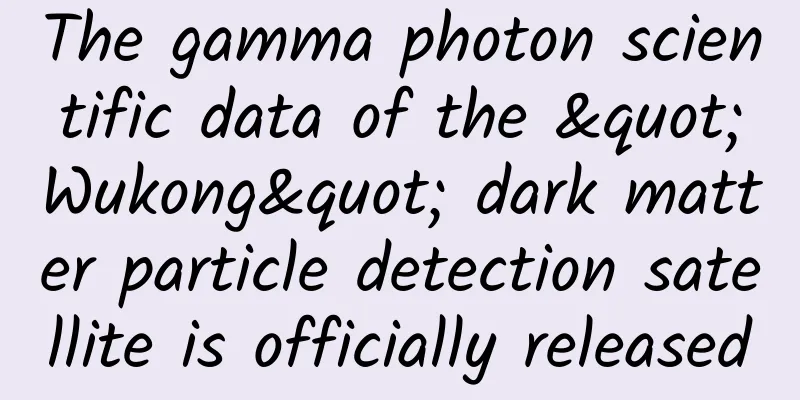The gamma photon scientific data of the "Wukong" dark matter particle detection satellite is officially released

|
On September 7, 2021, the National Space Science Data Center of the National Space Science Center of the Chinese Academy of Sciences and the Purple Mountain Observatory of the Chinese Academy of Sciences jointly released the first batch of gamma photon scientific data from the dark matter particle detection satellite "Wukong". As one of the important means for humans to understand the universe, space gamma-ray observation plays an active role in the research of cutting-edge scientific issues such as the origin of the universe and dark matter detection. The gamma photon scientific data from January 1, 2016 to December 31, 2018 (a total of 99,864 events) and the related satellite status files (a total of 1,096 records) released this time can be obtained through the National Space Science Data Center or the Purple Mountain Observatory of the Chinese Academy of Sciences. Gamma-ray exposure of Wukong Project Background The Space Science Pilot Project (Phase I) is one of the "Innovation 2020" Category A pilot projects approved by the State Council in 2010. It was officially launched on January 11, 2011. It aims to focus on the most advantageous and most significant scientific hotspots, achieve major scientific breakthroughs through independent and international cooperation scientific satellite programs, drive the leapfrog development of related high technologies, and play an important strategic role of space science in national development. The project is led by the National Space Science Center of the Chinese Academy of Sciences. Satellite Analysis The Dark Matter Particle Explorer (DAMPE, also known as Wukong) was successfully launched on December 17, 2015 at the Jiuquan Satellite Launch Center as the first satellite of the Space Science Pilot Project (Phase I). Its main scientific goal is to find evidence of the existence of dark matter particles by observing high-energy electrons (including positrons) and gamma-ray energy spectra in space, and to conduct related research on the origin of cosmic rays and gamma-ray astronomy. After five and a half years of stable operation, the Wukong satellite platform and payload are currently working normally. It has completed more than 11 full-sky scans and obtained about 10.7 billion high-energy cosmic ray events. It has successively obtained the most accurate measurement results of cosmic ray electrons, protons, helium nuclei and other energy regions above TeV, making important contributions to the indirect detection of dark matter and the origin of cosmic rays. The payload of Wukong consists of four sub-detectors (Plastic Scintillator Array Detector PSD, Silicon Array Detector STK, BGO Calorimeter, Neutron Detector NUD). Among them, the Plastic Scintillator Array Detector is mainly used to measure the charge of incident particles and is used for anti-coincidence detection of gamma rays; the Silicon Array Detector is mainly used to measure the direction of incident particles. It is equipped with tungsten plates to convert gamma rays into positive and negative electrons to achieve accurate measurement of their direction, and can also measure the charge of incident particles; the BGO calorimeter is mainly used to measure the energy of cosmic ray particles, especially high-energy electrons and gamma rays, and to identify particles and eliminate the background of high-energy nuclides (including protons and heavy nuclides); the neutron detector is used to measure the secondary neutrons produced by the interaction between the hadrons in the cosmic rays and the matter on the upper layer of the neutron detector, and further eliminate the background of high-energy nuclides. "Wukong" payload structure diagram Release significance Indirect detection of dark matter particles, cosmic ray physics and gamma-ray astronomy are the three major scientific goals of "Wukong", and the observation of gamma rays is one of the important means to achieve its scientific goals. Since gamma photons are uncharged and will not be deflected by magnetic fields during propagation, they can better carry information about the spatial distribution of dark matter. Therefore, gamma-ray data is of special value in indirect dark matter detection research. The gamma-ray observations of the Dark Matter Particle Detector Satellite have extremely high energy resolution and are expected to better study the properties of dark matter. Observations by existing gamma-ray space telescopes have shown that there are many celestial bodies and rich astrophysical processes in the gamma-ray band that are worth studying. The Dark Matter Particle Explorer satellite has certified more than 200 stable gamma-ray sources (including active galactic nuclei, pulsars, pulsar wind clouds and supernova remnants) in gamma-ray data above 2 GeV, which can be used to study the black hole jet components of active galactic nuclei, the mechanism of pulsed radiation produced by pulsars, and the contribution of supernova remnants to cosmic ray acceleration. The gamma-ray data of the Dark Matter Particle Explorer satellite will also provide new observational information on the formation mechanism of the huge gamma-ray bubble newly discovered by the Fermi satellite at the center of the Milky Way. Mining these gamma-ray data will also hopefully provide independent observations of gamma-ray time-varying sources. Data Decryption Gamma photon scientific data mainly include photon data files and satellite status files. Photon data files are obtained by selecting photons from the event data detected by the satellite. The files mainly record the physical information and GTI (good time interval) information of the photon data: physical information includes photon arrival time, reconstruction energy, reconstruction direction, trigger type, etc.; GTI information records the time information of the satellite observation mode. Satellite status files mainly record information such as satellite time, position, speed, direction and effective time. In order to facilitate data analysis for scientists around the world, gamma-ray advanced data analysis software DmpST is also provided to assist in scientific data analysis. Special thanks to the Dark Matter Particle Explorer Satellite collaboration for their important contributions to gamma photon science data processing, quality control and analysis software. "Wukong" gamma photon scientific data all-day count chart Subsequently, the National Space Science Data Center and the Purple Mountain Observatory of the Chinese Academy of Sciences will continue to release gamma photon science data, carry out research and development of data analysis and application technologies and tools, and provide the public with more diverse, more refined and more transparent data sharing and application services. |
<<: Is the oral irrigator useful? Is it just a waste of money?
Recommend
New discovery | Intestinal flora affects obesity!
Obesity is a global public health issue. Some stu...
WeChat quietly launches a new feature: videos can be used as Moments covers
[[418348]] Have you noticed? WeChat Moments can n...
As the weather gets warmer, why do small flying insects "prefer" people wearing brightly colored clothes?
□ Science Times reporter Hu Lijuan As the weather...
Zhihu advertising, Zhihu advertising forms
Zhihu community is the largest knowledge platform...
Okra vs. Datura? Taro vs. Water-dropping Goddess of Mercy? Celery vs. Poison Hemlock? They look similar but are really inedible.
Toxic and inedible series: Okra vs. Datura? Taro ...
Don't criticize Baidu, no one is innocent
[[162080]] Recently, the Baidu selling forum even...
When moms step out of the kitchen and become forest firefighters
Not long ago, a Korean reality show called "...
From DHT to DM-i, how attractive are the hybrid technologies of BYD and Great Wall that are frequently released?
For many years, when we talk about hybrid technol...
Product operation tips: What are the methods to improve product conversion rate?
When we start promoting a product, the first thing...
Media question taxi reform: Why not cut membership fees?
In the taxi operation business, taxi drivers and ...
Apple iOS 9 may integrate smart home applications
Beijing time, May 21 morning news, American techn...
Zhihu Product Analysis Report
In 2021, Zhihu celebrates its tenth anniversary, ...
Pre-Qin ritual books are rediscovered! The “Tsinghua Bamboo Slips” are the first to discover such documents from the Warring States Period →
Recreating the original appearance of the ritual ...
2021 Xiaohongshu High-efficiency Marketing Manual
Xiaohongshu is a lifestyle sharing platform that ...
What does Baidu Xingfa account mean, and what is the difference between it and Baidu Port Framework account?
What does Baidu Xingfa account mean, and what is ...









